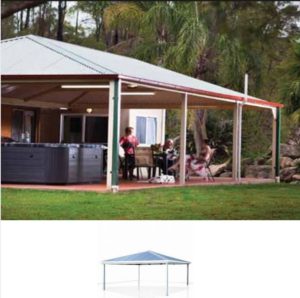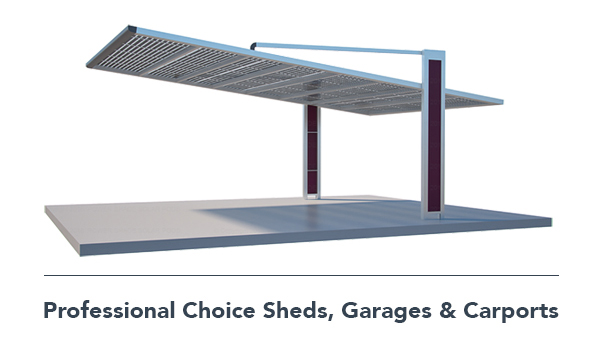Professional Choice Sheds & Garages – workshops – Ph: 0425 230 866 or 1300 851 038
Shed and Carport Regulations in Australia – a guide
Shed and Carport Regulations in Australia – a guide
Shed and Carport Regulations in Australia – a guide
It is the carport or shed owner/property owner’s responsibility to check out all local regulations and seek any council approvals that may be necessary in the area. Rules and regulations not only differ in States and Territories but can differ considerably between one local council and another. The following should be treated as a guide only.
NOTE – In most councils and states a garden shed less than 10m square does not usually require any permission but you should check. The information below is more concerned with carports and sheds larger than 10 square metres.
A new shed or carport should complements the style of the older home.
Shed and carport building regulations can vary from state to state and even council to council. The information on this page is meant as a guide only. You will need to check with your local authority as to what is permissible in your area.
Council permission is necessary in most locations before erecting a shed or carport
The list below are things you should check with your local authority before building a carport.

How do I find the right information? Shed and Carport Regulations in Australia – a guide
It can be very challenging finding the right information for your property and the best place to start is your local council website. Many have fact sheets on their websites for sheds and carports and minor domestic structures, so simple search for ‘carport’ in the search box in the home page.
What is a carport?
Most of the legislation defines a carport as a structure primarily used for housing a vehicle that is open on at least two sides and one third of the shed or carport’s total perimeter.
In the Building Code of Australia (BCA), a carport is classified as a Class 10a Building.
What is a shed?
The size, shape and location of the shed must not make it dominate the surrounding landscape and while a shed is a relatively informal structure it must still be built to the minimum Building Codes of Australia standards.
How many sheds and carports can you have? Shed and Carport Regulations in Australia – a guide
In NSW, you’re allowed one carport per residential dwelling on the site. Other states appear not to have specified this criteria or it varies from local council to local council.
When are carports not allowed?
A small or unusually shaped section can cause problems so check the local regulations to see if a carport is allowed on your property. For example, in NSW, when the property is less than 8m wide and there is no vehicle access from a secondary road (i.e. not the primary road), a carport cannot be built.
In many states, a battleaxe section requires space to turn the car around so it can drive off the property in a forward direction. This limits where (or if) a carport can be placed.
Will the shed or carport need a building permit?
It’s best to assume that your shed or carport will require a permit and most states require one and it’s a good place to start.
New South Wales
When the carport meets the specific development standards in the policy, it doesn’t need a permit.
If any heritage item (or proposed item), is on the site, the carport will need a permit and in foreshore areas, the carport will need a permit
Victoria
Under Schedule 8 of the Building Regulations 2006, a carport (as a Class 10a building), does not need a permit if
- Floor area is less than 10m2.
- Height is less than 3m or 2.4m within 1m of the boundary.
- It is attached to another building on the same property
- Is located behind the front wall of the main building
- Not constructed of masonry
Northern Territories
Carports will usually need building approval and this can be obtained from an NT-registered Building Certifier or an approved Self-Certifying Manufacturer.
Tasmania
Carports require a permit from the local council.
Queensland
You will generally need building approval for a carport and note the zone your property lies within this is very important, so be sure you know which zone you live in.
South Australia
You will need to apply for approval in most cases from the local council or a private certifier. Fortunately, carports that meet the requirements laid out in the Residential Code require only building approval, not planning assessment or consent, and they should be approved within 25 working days.
Western Australia
Carports require a Building License and Development Approval.
What is the maximum height and floor area of the carport?
Maximum heights vary, as does the part of the structure is being measured to ascertain the ‘height’ so you will need to contact your local council to find out what applies to you and keep these things in mind:
- The maximum height may change depending on how close the carport is to the boundary and neighbouring buildings.
- There may also be considerations for the average height of the building, if the carport is to be attached to an existing structure.
- Shading of other houses needs to be taken into account when deciding on the height of the building.
Floor area allowances also vary and in some states, the zoning of the property may affect how large the carport area can be so before you decide on the size of your carport, know for certain which zone you are in.
What are the limitations on placing a carport near the boundary line or with concern to easements?
The frontage setback will be subject to local Council controls which will dictate how close the building can be built to the footpath. Don’t assume you can build it where you like…check first!
What are the regulations concerning carports in bushfire prone areas?
As stated in the BCA, a Class 10a building associated with a Class 1 building (a residential home) needs to provide resistance to bushfires. Further, a class 10a must not significantly increase the risk of fire spread between buildings.
For those in bushfire prone areas, it’s advisable to read through “3.7.1.6 Class 10a buildings” for a full description.
How should you dispose of the water from the roof?
An oft-forgotten aspect of building a carport is the rainwater run-off so note the states listed below which have requirements for carport rainwater runoff disposal.
In NSW, any water that runs off the roof of your carport must run into an existing stormwater drainage system.
At the time of writing, Victoria was revising their rainwater collection rules to be more environmentally friendly.
In Queensland, the rules appear to change from council to council. For example, Ipswich Council advises roofwater must be piped to an appropriate stormwater discharge point, while Gympie encourages the use of rainwater tanks.
South Australia appears to be more flexible on how the water will be disposed, but it must be outlined in the building approval application.
Can you connect the carport to the house?
So long as it’s within the engineer’s specifications.
Are there any regulations on the appearance of the shed or carport?
Last but not least – check that your local council does not have requirements as to the appearance of your carport
